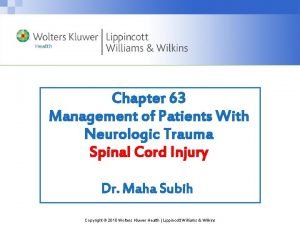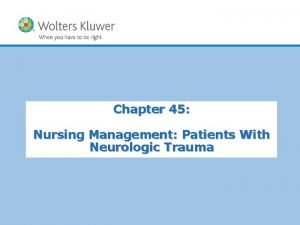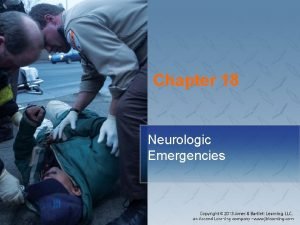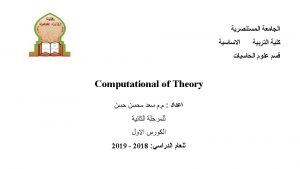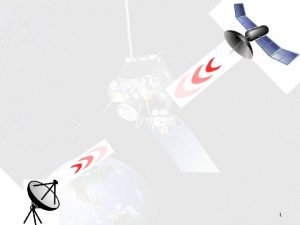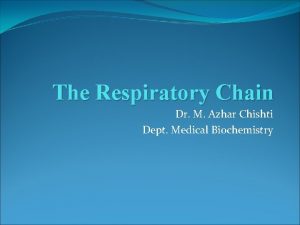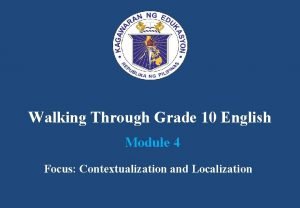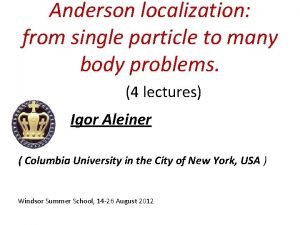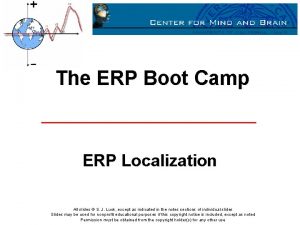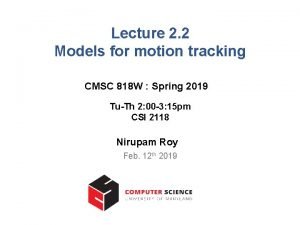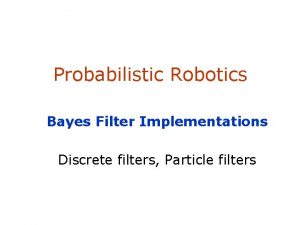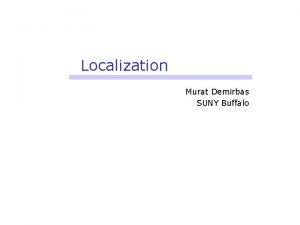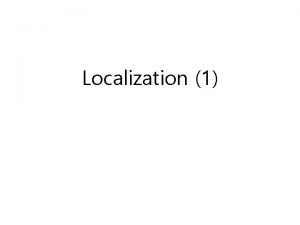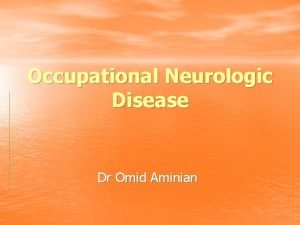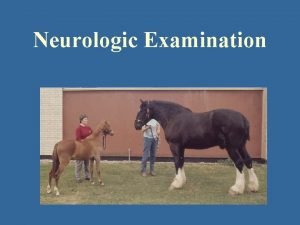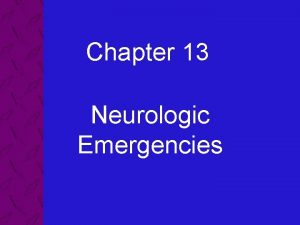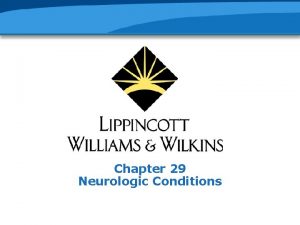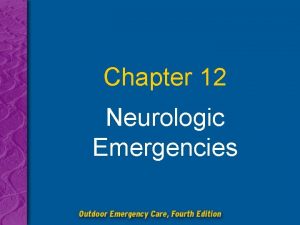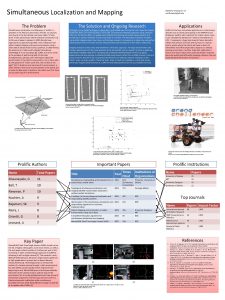Neurologic localization Prof Saad M Alrajeh M D



































- Slides: 35

Neurologic localization Prof. Saad M. Alrajeh, M. D. , FAAN, MANA




Central nervous system ¡ The CNS (upper motor neuron) includes the brain and spinal cord. Upper motor neuron lesions result in cognitive disorders, spasticity, hyperreflexia, sensory alterations, and pathologic reflexes. l l l l Cerebral hemispheres White matter tracts Cerebellum Basal ganglia Cranial nerves I and II Spinal cord In general, cerebral lesions involving grey matter (cortex) are associated with defects in higher cortical function (e. g. . dementia, aphasia) and seizures, whereas those involving white matter (subcortex) are associated with paresis and hemisensory defects.

Peripheral nervous system ¡ The PNS includes lower motor neurons and the nervous outside the CNS. Lower motor neuron lesions result in weakness, flaccidity, sensory alterations, and loss of deep tendon reflexes but absence of pathologic reflexes l l l Cranial nerves III and XII Spinal nerves and nerves roots Cauda equina Lower motor neurons including anterior horn cells, nerve roots, peripheral nerves, neuromuscular junctions, and skeletal muscles plexuses

Frontal lobe ¡ ¡ ¡ FUNCTIONS: cognation, personality, speech, reasoning ability. COMMON LESIONS: Strokes, tumours, and trauma LESION RESULT IN: cognitive disorder (e. g. dementia), gaze deviation to side of lesions, aboulia (slowness of response) nonfluent aphasia, hemiparesis, partial seizers.

Temporal lobe ¡ ¡ ¡ FUNCTIONS: Memory and emotions. COMMON LESIONS: Tumours and trauma. LESIONS RESULT IN: Memory impairment, homonymous hemianopia, aphasia (if dominant hemisphere), complex partial seizures.

Parietal lobe ¡ ¡ ¡ FUNCTIONS: Sensation, praxis (ability to carry out desired acts). COMMON LESIONS: Strokes, tumours, and trauma. LESIONS RESULT IN: Hemiparesis, hemisensory deficits, apraxia (difficulty performing previously learned tasks), partial seizures.

Occipital lobe ¡ ¡ ¡ FUNCTION: Vision. COMMON LESIONS: Strokes, tumours, and trauma. LESIONS RESULT IN: Homonymous hemianopasia or blindness

Common localizin signs in focal epilepsy

Thalamus ¡ ¡ ¡ FUNCTIONS: Integration of sensory functions. COMMON LESIONS: Strokes, haemorrhage LESIONS RESULT IN: Altered sensation and pain on opposite side, gaze deviation usually to side of lesion.

Internal Capsule ¡ ¡ ¡ FUNCTIONS: Pathway for motor and sensory systems. COMMON LESIONS: Strokes, haemorrhage. LESIONS RESULT IN: Contralateral hemiparesis and hemisensory deficits.

Cerebellum ¡ ¡ ¡ FUNCTION: Balance and coordination. COMMON LESIONS: Strokes, haemorrhage. LESIONS RESULT IN: Ataxia, dysmetria, incoordination.

Midbrain ¡ ¡ ¡ FUNCTIONS: Integration of vertical eye movement, sensory and motor function. COMMON LESIONS: Stroke. LESION RESULT IN: Papillary dilatation, paralysis, oculomotor weakness frequently accompanied by contralateral hemiparesis, tremor, or ataxia; paresis of upgaze.

Pons ¡ ¡ ¡ FUNCTION: Vital function (e. g. . , breathing, consciousness, cardiac function), motor and sensory functions, lateral eye movement. COMMON LESIONS: Stroke, Multiple sclerosis. LESIONS RESULT IN: Hemi- or quadriplegia, pinpoint pupils, horizontal gaze palsy, internuclear opthalmoplegia, coma or “locked-in” state; upbeat nyastagmus is common.

Medulla ¡ ¡ ¡ FUNCTION: Swallowing, cardiac function, balance, lingual movements, motor and sensory function. COMMON LESIONS: Strokes, syrnix. LESIONS RESULT IN: Lateral medullary or Wallenberg's syndrome (crossed sensory syndrome- numbness on one side of the face and the opposite side of the body, hoarseness, dysphagia, Horner's syndrome, and ipsilateral ataxia); medial medullary syndrome (ipsilateral tongue deviation and contralateral hemiparesis).

Cervical spinal cord ¡ ¡ ¡ FUNCTIONS: sensory and motor function of the arms and legs. COMMON LESIONS: usually spondylosis (cervical degenerative joint disease), MS, trauma. LESIONS RESULT IN: Quadra- or paraparesis, spasticity in arms and legs with Babinski’s sign, sensory level in cervical area, urinary retention, loss of position sense.

Thoracic spinal cord ¡ ¡ ¡ FUNCTION: Motor and sensory functions of the arms and legs, bladder function. COMMON LESIONS: usually tumours metastatic to bone or intradural tumours (e. g. meningioma, neurofibromas); strokes and herniated disks are rare. LESIONS RESULT IN: spastic paraparesis or paraplegia with bilateral Babinski’s sign; sensory level in thoracic area; urinary retention; loss of position sense in feet (unless anterior spinal artery syndrome, in which posterior column function spared).

Conus medullaris FUNCTION: bladder and bowel function. ¡ COMMON LESIONS: usually tumours in region of L 1. ¡ LESIONS RESULT IN: Saddle anaesthesia, bladder and bowel dysfunction, pain in legs may occur late in course. ¡

Cauda equina FUNCTIONS: Sensory and motor function in legs, bladder and bowel function. ¡ COMMON LESIONS: Usually herniated lumbar disks or maningeal cancer. ¡ LESIONS RESULT IN: Scattered pain and weakness in legs, loss of knee and/or ankle reflexes, bladder and bowel dysfunction. ¡

Spinal cord localization

Spinal cord syndromes

Anterior horn cells FUNCTIONS: Motor function to individual muscles. ¡ COMMON LESIONS: Usually motor neuron disease (e. g. . , ALS) ¡ LESIONS RESULT IN: Weakness, flaccidity, fasciculation, and atrophy in the distribution of the motor unit, loss of reflexes. ¡

Nerve root FUNCTIONS: Sensory and motor function to individual muscles. ¡ COMMON LESIONS: Disk herniation. ¡ LESIONS RESULT IN: Usually causes pain and parasthesias in the dermatomal distribution and weakness in myotomal distribution. ¡

Peripheral nerve FUNCTIONS: Sensory and motor function to individual muscles. ¡ COMMON LESIONS: Usually peripheral neuropathies, solitary nerve or plexus lesions, mononeuritis multiplex. ¡ LESIONS RESULT IN: Numbness, paresthesias, weakness, flaccidity, loss of reflexes, and loss of vibratory and position sense in the nerve distribution. ¡

Neuromuscular junction FUNCTION: Motor function to individual muscles. ¡ COMMON LESIONS: Usually myasthenia gravis. ¡ LESIONS RESULT IN: Variable weakness with fatigability; absence of sensory findings and normal reflexes. ¡

Muscle disease FUNCTION: Movement of joints and strength. ¡ COMMON LESIONS: Usually muscular dystrophies or polymyositis. ¡ LESIONS RESULT IN: Proximal muscle weakness with intact reflexes and absence of sensory symptoms or findings. ¡

Neuroimaging Common neuroimaging modalities include: ¡ X-ray ¡ CT scanning ¡ MRI ¡

Computerized tomography (CT) scans ¡ Excellent initial investigations for cerebral lesions, particularly because it is quick and universally available. ¡ Excellent use in trauma, intracerebral haemorrhage, and shift in midline structures. ¡ Contrast enhancement is necessary for evaluation of stroke and neoplasm.

Computerized tomography (CT) scans ¡ ¡ ¡ Weakness of CT scanning: fails to show infarcts for up to 24 h, unable to detect early stage subdural haematoma, lack of anatomic detail, fails to identify multiple sclerosis plaques, and detection of neoplasms require contrast enhancement. If used with mylography, CT scanning may be helpful in spine disease or ruptured disks. May be a necessary test in patients who cannot undergo MRI scanning (e. g. , claustrophobia, pacemaker, metallic stent, aneurysmal clips)

Magnetic Resonance imaging (MRI) ¡ Gives excellent anatomic detail and shows virtually all structural diseases. ¡ Diffusion weighting image (DWI) is extremely valuable to identify early stroke signs. ¡ Apparent diffusion coefficient (ADC) maps may show restricted diffusion (e. g. , stroke). ¡ Perfusion imaging is helpful in demonstrating area at risk in stroke (ischemic penumbra)

Magnetic Resonance imaging (MRI) ¡ ¡ ¡ Gradient echo is helpful for hemorrhage, both old and new. T 2 weighting shows edema and white-matter lesions well. FLAIR sequences are useful for evaluation of multiple sclerosis. Contrast enhancement with gadolinium will show neoplasms and enhance meninges. A superb non-invasive test for spinal cord disease or herniated disks in cervical or lumbar region.

Imaging of the cerebral circulation ¡ Magnetic resonance angiography (MRA) is initial imaging of choice; 2 -D time of flight shows extracranial circulation (vertebrals and carotid bifurcations); 3 -D time of flight demonstrates intracranial circulation; contrast enhanced studies will show aortic arch and aortic braches. ¡ CT angiography (CTA) with reconstructed views will demonstrates cervical and intracranial circulation well; better than MRA for detecting cerebral aneurysms. ¡ Magnetic resonance venogram (MRV) may be performed to evaluate suspected venous sinus occlusion. ¡ Carotid duplex US is non-invasive method of identifying carotid stenosis; widely used but accuracy is very technician-dependant; less useful in posterior circulation. ¡ A combination of MRI, CTA, and carotid Doppler usually accurately determines the degree of carotid stenosis; otherwise, catheter angiogram may be necessary.

Imaging of the cerebral circulation ¡ Transcranial Doppler may be helpful in identifying intracranial stenosis or occlusion; also used to identify cerebral emboli as there is an audible signal that can be imaged as well; however, highly technician dependant. ¡ Catheter angiography is still considered the “gold standard” for identifying arterial stenosis and aneurysms; carries a risk 1% risk of stroke as complication; generally necessary only to determine the degree of extracranial carotid artery stenosis in preparation for endratrectomy or stenting; however, accuracy of MRA, CTA, and Doppler US is usually sufficient such that catheter angiogram is needed only when uncertainty remains; may be necessary to identify arteriovenous malformations.
 Lippincott williams & wilkins
Lippincott williams & wilkins Management of patients with neurologic trauma
Management of patients with neurologic trauma Chapter 18 neurologic emergencies
Chapter 18 neurologic emergencies Chapter 17 neurologic emergencies
Chapter 17 neurologic emergencies Saad mohsen ٨- احذر احذر
Saad mohsen ٨- احذر احذر Dr sadia saad
Dr sadia saad Télégestion saad
Télégestion saad Klodia saad
Klodia saad Dr hussein saad
Dr hussein saad Tidal energy assignment
Tidal energy assignment Manufacturing strategies
Manufacturing strategies Saad ahmed economics
Saad ahmed economics Saad alshahrani
Saad alshahrani Saad ahmad md
Saad ahmad md Joanne saad
Joanne saad Saad ahmed javed
Saad ahmed javed Avp 3
Avp 3 Saad bashir
Saad bashir Saad azhar saeed ucp
Saad azhar saeed ucp Localization and contextualization
Localization and contextualization Tube shift technique
Tube shift technique Example of contextualization and localization
Example of contextualization and localization Localization courses
Localization courses Anderson localization lecture notes
Anderson localization lecture notes Inclusive localization
Inclusive localization Data localization in distributed database
Data localization in distributed database Localization of function ib psychology
Localization of function ib psychology Cump erp
Cump erp Localization in html5
Localization in html5 Monte carlo localization for mobile robots
Monte carlo localization for mobile robots Tracking cmsc
Tracking cmsc Voice localization using nearby wall reflections
Voice localization using nearby wall reflections Lqa language quality assurance
Lqa language quality assurance Dnn localization
Dnn localization Markov localization
Markov localization Bayes filter
Bayes filter
